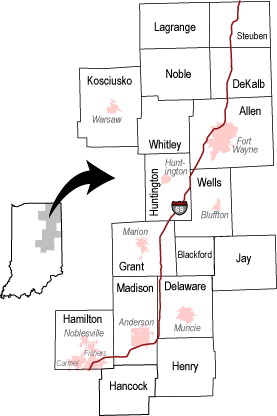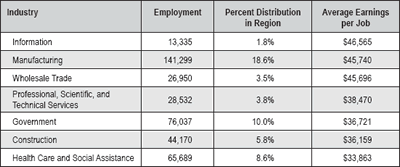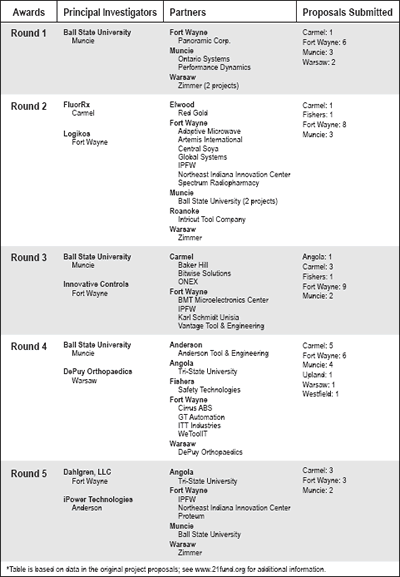Letting It Ride on Indiana's Technology Belt
Adjunct Faculty, Ball State University; and Research Fellow, Indiana Business Research Center, Kelley School of Business, Indiana University
According to Louis Pasteur, “Chance favors the prepared mind.” Similarly, economic development success favors prepared communities. In a rapid response economy, choices are determined by paths of least resistance. States or regions that build infrastructure capacity proactively improve their odds of reaping financial rewards, although those rewards cannot be predicted. In Indiana, the high-speed Interstate 69 thoroughfare is morphing into an elongated technology belt, connecting clusters of innovative activity.
Even with all the hype about meetings in cyberspace and working in hermitic isolation, the dissemination of ideas still tends to be a social infection. Studies of technology clusters by the Miliken Institute and others show that innovation thrives in areas where new ideas are pitched like salmon in Seattle’s Pike Place Market. People gather to innovate. The I-69 technology belt facilitates intercommunity collaboration. This is beginning to create a counterbalance to the dominant Indianapolis metro area. Indiana and its people will benefit from the decentralization of its economy and the development of multiple innovation clusters. Other clusters are developing around Bloomington/Crane and along I-65, from Lebanon to Greater Lafayette to Gary/Hammond.
Regional Overview
The counties bordering I-69 (with the additions of Kosciusko County, connected via State Road 30, and Jay County) accounted for 21.7 percent of the state’s 2002 population and 18.5 percent of its geographic area (see Figure 1).
Figure 1
The I-69 Technology Belt

At 13.7 percent, its population growth rate between 1990 and 2000 exceeded Indiana’s (9.7 percent). This growth is expected to slow somewhat, to 11.5 percent by 2010, according to projections from the Indiana Business Research Center. Per capita income in 2001 was 104.2 percent of the state average. The 5.7 percent unemployment rate for the region in January 2004 was 101.8 percent of the state average. Top-paying industries for the region in 2001 are shown in Table 1.
Table 1
Top-Paying Industries in the I-69 Region, 2001
The region contributed 22.6 percent of the state’s high school graduates for 2000–2001, with 23.7 percent of those graduates intending to go for a four-year post-secondary degree. The region accounted for only 13.7 percent of state welfare (TANF) families in 2001 and 16.3 percent of food stamp recipients. Fort Wayne, Muncie, and Anderson are the three largest cities or towns with a combined 2002 population of 336,118 (25.2 percent of the region’s total). The next three largest cities are part of the Indianapolis metro: Fishers, Carmel, and Noblesville.
Certified Technology Parks
As part of the Energize Indiana initiative, the Indiana Department of Commerce began accepting applications in early 2003 for special tax districts to encourage high-tech business development. Two of the state’s seven certified technology parks are located within the I-69 belt. In addition, Muncie has received preliminary approval of its application for a certified technology park designation.
Anderson’s Flagship Enterprise Center was the second park to be certified under the state program and represents the successful partnership of the city, Anderson University (Falls School of Business), the Purdue School of Technology, and Ivy Tech. The Northeast Indiana Innovation Center in Fort Wayne was the fifth park certified under the state program. It represents the partnership of the city, Indiana University–Purdue University Fort Wayne (IPFW), and Ivy Tech.
The Indiana 21st Century Research and Technology Fund
The Indiana General Assembly created the 21st Century Research and Technology Fund to promote economic diversity through the commercialization of technological innovation. Money is awarded to project teams comprised of one principal investigator (often a university) and multiple partners. The fund encourages, indeed requires, participation by a mix of academic and private sector entities. Groups in the I-69 technology belt are involved as either project principal investigators or partners in all five rounds of awards as seen in Table 2.
Table 2
I-69 Corridor Involvement in the 21st Century Research and Technology Fund
Click for larger image
Innovation Clusters
The I-69 technology belt is home to companies representative of Indiana’s four high-tech areas: advanced manufacturing, twenty-first century distribution/logistics, information technology, and life sciences. Many of these companies have been around for decades and have adapted to new market opportunities.
The region is home to the largest software development company in the state (Ontario Systems (1)) as well as the largest orthopaedic device company (Zimmer (2)). The medical device industry, rather than the pharmaceutical industry, is the life sciences subsector that is especially significant to communities in Allen and Kosciusko counties. The big three device companies (Zimmer, Biomet, and DePuy Orthopaedics) employ approximately 25 percent of the full-time workforce in Kosciusko County. Many other residents work for suppliers to biotechnical companies in the region, such as Fort Wayne Metals. The presence of these biotech companies helps traditional companies transfer their precision manufacturing expertise to production for an expanding marketplace.
I-69 was conceived in the 1950s as part of a national transportation solution and, fittingly, Indiana communities along this technology belt continue to devise innovative transportation solutions. A global supplier of alternators for automotive, marine, and trucking applications, Delco Remy International has redefined its product as mobile power generation. Along the way, it formed a partnership to establish iPower Technologies and “pursue emerging opportunities in distributed generation for full-time, on-site power generation that integrates with existing public power grids or operates independently if there is a blackout or in emerging areas or countries with inadequate infrastructures.” (3)
Allen County lost the International Harvester truck production facility to Ohio in the early 1980s—but its international truck engineering and design facility remains in Fort Wayne and employs more than 1,200 engineers. Do It Best Hardware, a global cooperative for hardware and lumber dealers, was praised by management guru Tom Peters as early as 1992 for its innovative use of state-of-the-art communications systems, including monthly video training meetings. It continues to use technology to streamline costs for its members.
The engineering focus of companies like Raytheon, General Dynamics, ITT, and Northrup Grumman has encouraged development of communications applications. For example, advances in radio frequency technology led to product development opportunities for companies, ranging from Logikos’ interface for police squad cars to Innotek’s pet containment systems to Northern Apex’s work on RFID-based inspection tags for elevators and amusement park rides. Students and faculty at Taylor University have developed a communications satellite that is intended to provide a low-cost messaging alternative for remote villages in third world countries. (4)
Creation of digital content for communications applications is being explored by groups along the I-69 technology belt. Paws, Inc. is the Fairmount-based home and distribution center for Garfield the Cat products. Movielink, the video-on-demand service, has formed a research development relationship with Ball State to explore how students use video services and, in particular, how their legitimate use can be promoted. Distance learning initiatives are underway in both Fort Wayne and Muncie.
Communications Infrastructure Initiatives
Grassroots initiatives are driving the deployment of the communications infrastructure necessary to accommodate twenty-first century businesses in this region. In the three cases cited, progress is being driven by commitments from local government, economic development organizations, academic institutions, and commercial consumers of telecommunications services.
Fort Wayne released its iConnect proposal request (RFP) in late 2001 and awarded the multi-phase contract to the Indiana Data Center (INDDC) in March 2002. At present, the unlicensed wireless spectrum system offered by the INDDC reaches roughly 80 percent of Fort Wayne businesses, including a number of businesses which could not be served by other fiber- or copper-based providers. Taking advantage of existing water towers and other city-owned structures for locating equipment, the system was 10 percent to 50 percent less expensive than wired broadband. The estimated installation fee of $500 is about one-third the cost of the typical connection fee for a T-1 line. Motorola did a case study of this Phase I wireless project, which is posted on the INDDC website (www.inddc.com). Building on the Fort Wayne broadband initiative, the INDDC is now extending coverage into other cities, including Angola, Auburn, and Huntington.
The Muncie/Delaware County Vision 2006 broadband initiative has attracted $600,000 in funding for the development of an ultra-broadband wireless testbed. Speeds of up to 30 megabits per second (Mbps) have been attained at test locations near the Ball State University campus. The initiative also includes planning for the deployment of more affordable broadband in the 3 Mbps to 4 Mbps range for those with more modest performance requirements. Related activities at Ball State include the proposed establishment of a telecommunications carrier “hotel” in Muncie and the formation of the Rural Broadband Research Center. The latter would benefit from ongoing student/faculty projects conducted under the aegis of the iCommunications Media Design Initiative. (5)
Other initiatives include Jay County’s microwave network that connects its ten schools, implemented at a cost of about $160,000, and the Anderson Power and Light project to send broadband over power lines. On the commercial side, Indiana Fiber Works is completing its fiber rings. (6) The “end points” will be prepared for the I-Light 2 buildout.
Of course, expanding broadband supply is just one side of these community-based technology initiatives. Stimulating consumer demand is imperative for attracting investment from telecommunications carriers and for ensuring an acceptable payback period for local government investment.
In Fort Wayne, the city government has implemented eGovernment applications that have earned national recognition. The Center for Digital Government rated Fort Wayne number one among midsize U.S. cities. Online services for citizens include utility bill payment, pothole reporting, and GIS mapping to explore desirable neighborhood amenities. Online services also improve productivity for government officials. According to a feature article in the April 2004 issue of Kiplinger’s, “police officers can pull up to ‘hot spots’ near fire stations and get wireless downloads.” Wireless fingerprint identification at the point of suspect apprehension is coming soon.
The Vision 2006 Technology Committee recently completed a survey of businesses in four neighboring counties (Blackford, Delaware, Grant, and Jay) that indicates a high level of acceptance for broadband and other Internet-related technologies. In fact, 75 percent of the 114 survey respondents connect to the Internet via DSL, cable, or T-1 (and higher) circuits. By contrast, the survey results from the 2003 Indiana Interconnect study indicated only 34 percent of Indiana businesses using the Internet connect over broadband. Greater sophistication in the usage of Internet applications, as also noted in survey responses, quite possibly drives this demand for broadband.
Riding the Technology Belt
The communities that border the I-69 technology belt are preparing conscientiously for taking a chance on the twenty-first century. They are blessed with most of the necessary ingredients to create clusters of innovation: easy access to respected academic institutions, committed companies and civic leaders, and technological expertise. Venture capital funds have been established, in recognition that it is difficult to find “out-of-town” investors. The infrastructure for physical transportation—by air, rail, or road—works well. Cooperative efforts across county lines to deploy cyber infrastructure are attracting interest from telecommunications carriers. Discussion is underway to establish a Rural Broadband Research Center as a resource for communities that are still “digitally challenged.” A chain of certified technology parks offers the hope of successful commercialization projects. Perhaps this will be a road well traveled.
Endnotes
- Software products include medical billing applications.
- Zimmer is now the largest orthopaedic device manufacturer in the world due to its recent acquisition of a Swiss company.
- Delco Remy International was formed through the leveraged buy-out of several GM subsidiaries in 1994.
- Taylor University was the only undergraduate university to win in the 2002 national United States Air Force Office of Space Research competition for university nanosatellite grants. Taylor will be the lead institution with eleven others, including Stanford University. More information is available at www.taylor.edu/academics/departments/physics-engineering.
- This initiative was funded by a four-year $20 million grant from the Lilly Endowment.
- This network will connect communities including Anderson, Muncie, Marion, Sweetser, and Swayzee.





